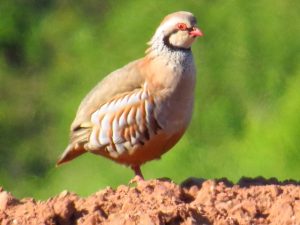Bird Notes by Jim Cassels
Birds are associated with Christmas. Robins are a favourite on Christmas cards and turkey, geese and chickens are feasted on. The traditional carol “The 12 Days of Christmas” features an array of birds, most of which would have been eaten at this festive time.
There are many versions of the carol. First published in English in 1780, the carol is thought to originate from an earlier French version. The pear tree referred to in verse one, it has been suggested, is perdrix. French for partridge and pronounced ‘per-dree’ it was copied incorrectly when the oral version of the carol was written down.
If the “partridge in a pear tree” is taken literally it is more likely to have been a red-legged partridge (French) which more readily perches in trees rather than the native Grey Partridge. The red-legged partridge was introduced into the UK around 1770.
The two turtle doves, being summer visitors to the UK, would have been unseasonal wild birds but could well have been caged as they are known as emblems of devoted love. The three French hens probably refer to domestic chickens, a still popular food.
The four calling birds, it is suggested, refer to four colley birds. That is four blackbirds, colley meaning black. You traditionally need “four and 20” for a pie but by the end of the carol you would have 30, six more than enough for a pie!
Five gold rings could refer to five “gold spinks” or goldfinches, another popular cage bird. Another interpretation is that it refers to ring necked birds such as pheasants, another popular table bird. Six geese and seven swans refer to birds that would have been eaten at the time the carol was written.
In the later verses, could the drummers drumming be common snipe and the pipers piping another wader like a sandpiper or an oystercatcher?
By the twelfth night, the table would have been heaving with 12 partridges, 22 doves, 30 hens, 36 blackbirds, 40 pheasants, 42 geese and 42 swans. After that, I would be surprised if the lords would have had energy for leaping or the maids for milking.
Have a good Christmas and enjoy your birding.
Please send any bird notes with “what, when, where” to me at Kilpatrick Kennels, Kilpatrick, Blackwaterfoot, KA27 8EY, or email me at jim@arranbirding.co.uk. I look forward to hearing from you. For more information on birding on Arran purchase the Arran Bird Report 2022 and visit the website http://www.arranbirding.co.uk/index.html

Robin are popular on Christmas cards. Photo Sue Archer
Red-legged partridge may feature in the famous carol. Photo Keith Betton